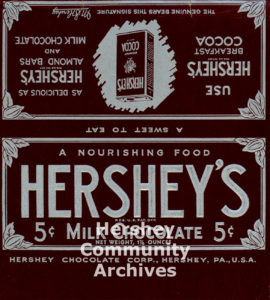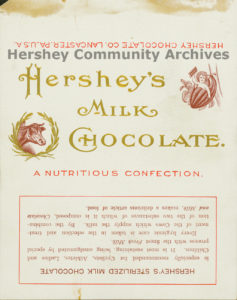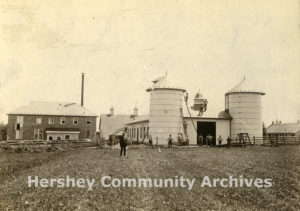Origins of Hershey’s Milk Chocolate

While Hershey’s Milk Chocolate is perhaps The Hershey Company’s most iconic product, perfecting the formula was one of the biggest challenges of Milton Hershey’s career. His interest in chocolate took off when he saw a display of chocolate making equipment at the 1893 Columbian Exposition in Chicago. At the time, he owned the successful Lancaster Caramel Company. However, Frank Snavely, a Caramel Company colleague, recalls Mr. Hershey saying, “Caramels are a fad; Chocolate is permanent. I am going to make chocolate.”
With that in mind, Mr. Hershey purchased the equipment and installed it in his caramel factory in Lancaster. He then began his experimentation in the world of chocolate. In 1894, when he formally incorporated the Lancaster Caramel Company, he established the Hershey Chocolate Company as a subsidiary. Prior to Hershey’s Milk Chocolate bars, the company produced “vanilla sweet chocolate” as a confectionery item. This was a semi-sweet chocolate, similar to what we would now consider dark chocolate. All the while, Mr. Hershey was working on a formula for milk chocolate and dreamed of making it an affordable treat for all. This would end up being his greatest contribution to the food industry.
Hershey was not the first to make milk chocolate, but he was the first to make it out of fresh milk using mass production techniques. The Swiss made milk chocolate out of powdered milk, and chocolate generally was an expensive treat for the rich. However, Milton Hershey had learned, during his travels in Denver, Colorado, how to use fresh milk to make caramels—a unique strategy he later employed at his Lancaster Caramel Company. He also wanted to use this technique for his milk chocolate. He was right in supposing fresh milk would be tastier and would keep longer. However, he did not know how difficult it was going to be to make chocolate this way.
It took Milton Hershey years of experimentation to conquer the obstacles to making milk chocolate with fresh milk. He had no knowledge of chemistry to help him in his search for a formula, so his method was trial and error. The first challenge was milk’s water content—about 87%—and moisture is the enemy of good chocolate. The solution to this was condensing the milk before adding it to chocolate.
The second challenge was milk’s fat content. At first, he tried to condense cream, boiling it in an open kettle. There were two problems with this method. First, the open kettle caused the milk or cream to get too hot. Second, chocolate made with cream went rancid. So, next he tried condensing whole milk. It tasted all right at first, but it did not hold up—after a while it also went rancid. Skim milk, condensed in a closed kettle, provided the solution.
The next challenge was determining when during the condensing process to add the sugar. Mr. Hershey discovered after many trials that adding the sugar prior to condensing enabled him to remove more of the milk’s moisture. The finished product was a thick, almost taffy-like condensed mixture of sugar and milk that mixed well with chocolate to create the perfect taste and texture for milk chocolate.
Milton Hershey conducted his first experiments with fresh-milk chocolate at his factory in Lancaster. After he sold the Lancaster Caramel Company in 1900, he retained rights to the Hershey Chocolate Company and maintained a small space in the factory to continue manufacturing his chocolate products. That same year, the Hershey Chocolate Company sold the first Hershey’s Milk Chocolate bars for the affordable price of 2 to 10 cents, depending on the size. The 5 cent bar later became the standard.

He continued to experiment with the formula even after these first bars were introduced. He built a small experimental milk condensing plant at the Homestead (his birthplace, located about a mile from where his factory would be constructed in Derry Township). There, he and a team of men worked diligently to perfect the condensing process and the formula. He was so dedicated to his experiments that he would often work day and night, not even emerging for meals.

When the Hershey Chocolate factory began production in 1905, Milton Hershey fulfilled his dream of mass-producing milk chocolate at price affordable to all. While the company originally produced a wide range of chocolate products in various novelty shapes, Mr. Hershey eventually decided to focus on a few, key items: the Hershey’s Milk Chocolate bar, Hershey’s Milk Chocolate with Almonds bar, and Hershey’s Kisses chocolates. While the company’s line of brands and products has expanded exponentially over the years, these milk chocolate products—that Milton Hershey was so dedicated to—remain iconic today.